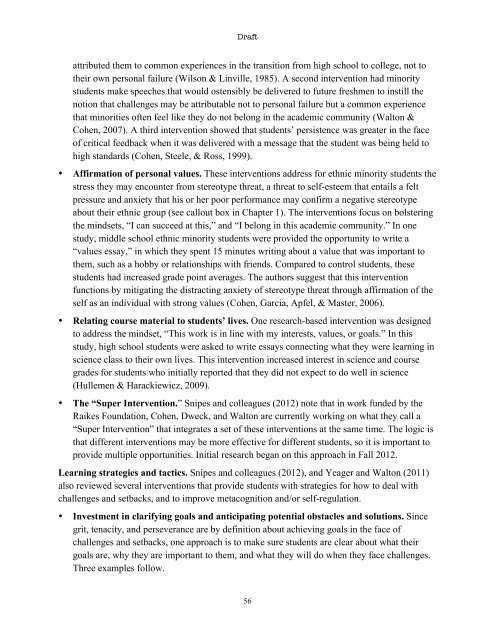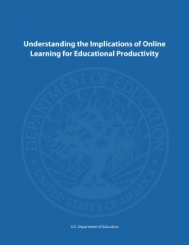Promoting Grit, Tenacity, and Perseverance - U.S. Department of ...
Promoting Grit, Tenacity, and Perseverance - U.S. Department of ...
Promoting Grit, Tenacity, and Perseverance - U.S. Department of ...
You also want an ePaper? Increase the reach of your titles
YUMPU automatically turns print PDFs into web optimized ePapers that Google loves.
Draft<br />
attributed them to common experiences in the transition from high school to college, not to<br />
their own personal failure (Wilson & Linville, 1985). A second intervention had minority<br />
students make speeches that would ostensibly be delivered to future freshmen to instill the<br />
notion that challenges may be attributable not to personal failure but a common experience<br />
that minorities <strong>of</strong>ten feel like they do not belong in the academic community (Walton &<br />
Cohen, 2007). A third intervention showed that students’ persistence was greater in the face<br />
<strong>of</strong> critical feedback when it was delivered with a message that the student was being held to<br />
high st<strong>and</strong>ards (Cohen, Steele, & Ross, 1999).<br />
• Affirmation <strong>of</strong> personal values. These interventions address for ethnic minority students the<br />
stress they may encounter from stereotype threat, a threat to self-esteem that entails a felt<br />
pressure <strong>and</strong> anxiety that his or her poor performance may confirm a negative stereotype<br />
about their ethnic group (see callout box in Chapter 1). The interventions focus on bolstering<br />
the mindsets, “I can succeed at this,” <strong>and</strong> “I belong in this academic community.” In one<br />
study, middle school ethnic minority students were provided the opportunity to write a<br />
“values essay,” in which they spent 15 minutes writing about a value that was important to<br />
them, such as a hobby or relationships with friends. Compared to control students, these<br />
students had increased grade point averages. The authors suggest that this intervention<br />
functions by mitigating the distracting anxiety <strong>of</strong> stereotype threat through affirmation <strong>of</strong> the<br />
self as an individual with strong values (Cohen, Garcia, Apfel, & Master, 2006).<br />
• Relating course material to students’ lives. One research-based intervention was designed<br />
to address the mindset, “This work is in line with my interests, values, or goals.” In this<br />
study, high school students were asked to write essays connecting what they were learning in<br />
science class to their own lives. This intervention increased interest in science <strong>and</strong> course<br />
grades for students who initially reported that they did not expect to do well in science<br />
(Hullemen & Harackiewicz, 2009).<br />
• The “Super Intervention.” Snipes <strong>and</strong> colleagues (2012) note that in work funded by the<br />
Raikes Foundation, Cohen, Dweck, <strong>and</strong> Walton are currently working on what they call a<br />
“Super Intervention” that integrates a set <strong>of</strong> these interventions at the same time. The logic is<br />
that different interventions may be more effective for different students, so it is important to<br />
provide multiple opportunities. Initial research began on this approach in Fall 2012.<br />
Learning strategies <strong>and</strong> tactics. Snipes <strong>and</strong> colleagues (2012), <strong>and</strong> Yeager <strong>and</strong> Walton (2011)<br />
also reviewed several interventions that provide students with strategies for how to deal with<br />
challenges <strong>and</strong> setbacks, <strong>and</strong> to improve metacognition <strong>and</strong>/or self-regulation.<br />
• Investment in clarifying goals <strong>and</strong> anticipating potential obstacles <strong>and</strong> solutions. Since<br />
grit, tenacity, <strong>and</strong> perseverance are by definition about achieving goals in the face <strong>of</strong><br />
challenges <strong>and</strong> setbacks, one approach is to make sure students are clear about what their<br />
goals are, why they are important to them, <strong>and</strong> what they will do when they face challenges.<br />
Three examples follow.<br />
56
















